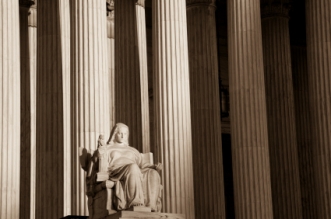 Is it legal to reduce pension cost-of living adjustments (COLAs) being paid to retirees? This question is a major issue, because of the value of COLAs for retirees and their high expense for pension plans. Recent reductions in retiree COLAs for several state and local government pension plans have brought legal challenges. The following paragraphs briefly examine how legal protections for COLAs differ in private sector and public sector pension plans. Recent cases offer less protection to public pension COLAs than previous cases, yet public pension COLAs still exist. In contrast, private plan COLAs have are rare, perhaps due to legal restrictions. Is a COLA that may be reduced better than none?
Is it legal to reduce pension cost-of living adjustments (COLAs) being paid to retirees? This question is a major issue, because of the value of COLAs for retirees and their high expense for pension plans. Recent reductions in retiree COLAs for several state and local government pension plans have brought legal challenges. The following paragraphs briefly examine how legal protections for COLAs differ in private sector and public sector pension plans. Recent cases offer less protection to public pension COLAs than previous cases, yet public pension COLAs still exist. In contrast, private plan COLAs have are rare, perhaps due to legal restrictions. Is a COLA that may be reduced better than none?
(a) Broad Level of Protection: Past State Court Decisions Protect Governmental Pension COLAs for Past and Future Accruals. Because state laws vary, there is no single “general rule” for public sector pension COLAs. However, some past state court decisions give public sector COLAs surprisingly broad protections. At least one decision prohibits COLA reductions for past and future pension accruals for active employees, e.g., Calabro v. City of Omaha, 247 Neb. 955, 531 N.W.2d 541 (1995). Another decision prohibits COLA reductions for employees who have worked for a “legally significant period of time” Nash v. Boise City Fire Department, 104 Idaho 803, 663 P. 2d 1105 (1983). These decisions protect COLAs not only for current retirees but also for benefits earned in the future by active employees, so that COLAs may only be cut back for newly hired employees or employees who have worked for less than a “legally significant period of time.” These decisions seem almost naïve in the simplicity with which they create potentially huge future COLA liabilities for state and local pension plans.
(b) Medium Level of Protection: ERISA Protects Private Sector Pension COLAs for Past Accruals. Unlike the COLA rules for public sector plans that were created by state courts, laws affecting private sector COLAs have been studied, written and revised over time by Congress, the IRS and the U.S. Department of Labor as well as federal courts. The resulting laws, which are more exacting than state court decisions, prohibit reductions in COLAs for past benefit accruals (with limited exceptions for very poorly funded plans). This approach allows reductions in COLAs for benefits earned in the future but not the past. Hickey v. Chicago Truck Drivers, 980 F. 2d 465 (7th Cir. 1992). The laws for private sector pensions also address the question: May a pension plan avoid this prohibition on COLA reductions by adopting a temporary or “ad hoc” COLA, or does that make the benefit too unreliable because it may be renewed (or not) at the discretion of the plan sponsor? Treasury regulations adopted in 2005 allow only limited use of “ad hoc” COLAs, by prohibiting a COLA (or other benefit) reduction if it is part of “a pattern of repeated plan amendments providing for similar benefits in similar situations for substantially consecutive, limited periods of time.” (Treas. Reg. section 1.411(d)-4 Q&A-1(c)(1).) In simpler (but less precise) words, a private sector pension plan may adopt a temporary COLA once or twice, but the COLA becomes a protected, permanent pension benefit after it is renewed several times.
(c) Low Level of Protection: Recent State Court Decisions Allow Public Pension COLA Reductions for Retirees. Recent state court decisions uphold COLA reductions for public sector pensions, reasoning that (1) the governing pension documents do not state that COLAs are protected contractual rights, and (2) the COLAs are not a protected benefit because they have been repeatedly adopted in varying forms over time. Justus v. Colorado (District Court for Denver City and County, 2011) and Swanson v. Minnesota, (Ramsey County District Court, 2011). Could these decisions approving “ad hoc” COLAs create a precedent that undermines the broader security of public sector pension benefits (a concern that tax regulations governing private sector pensions attempt to address with more detailed regulation)? Or do these decisions allow benefit flexibility that is necessary to continue to pay benefits from underfunded public pension plans (applying less stringent rules than apply to private sector pensions)? Which approach serves the interests of pension plan sponsors and participants more fairly and effectively? One thing is certain: future pension law developments will offer more examples of the trade-off between pension viability, flexibility and security.
Tags: COLAs, legal protections, pension, pension plans, private sector, public sector, retirees









